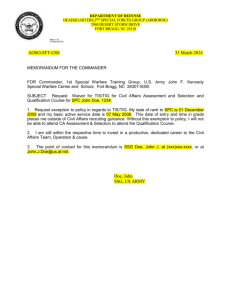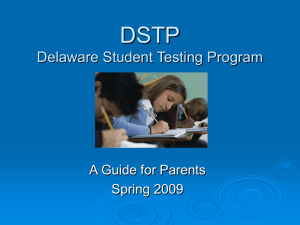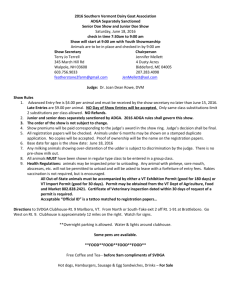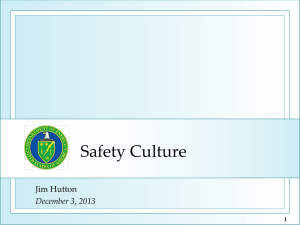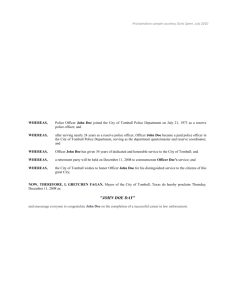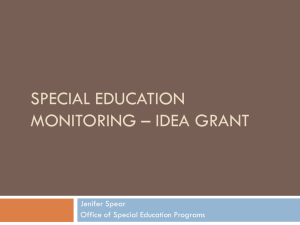Considerations for Software Test and Evaluation
advertisement
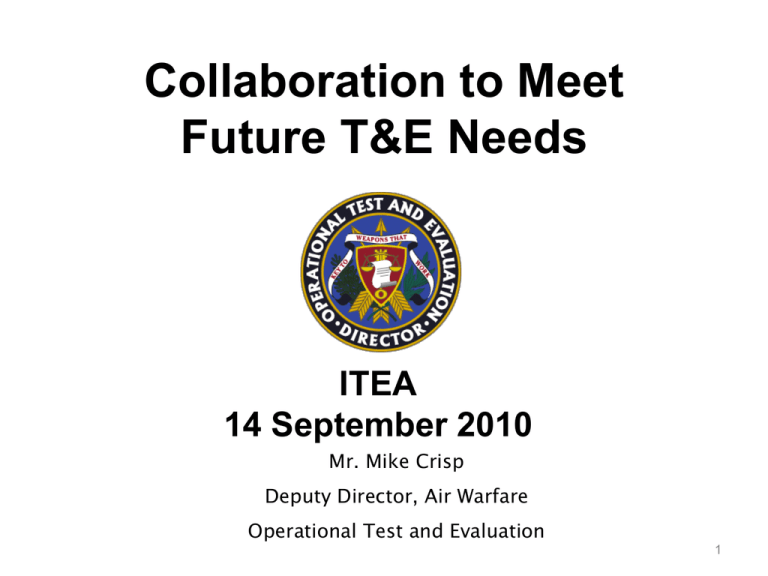
Collaboration to Meet Future T&E Needs ITEA 14 September 2010 Mr. Mike Crisp Deputy Director, Air Warfare Operational Test and Evaluation 1 Need vs. Speed vs. Cost: A Balancing Act in Acquisition • • • • Requirements Process stressed in Meeting Today’s Needs DoD Budgets Under Pressure Warfighter Demand Cycle inside Acquisition OODA Loop Concurrent Development, Production, Operations, and Support – Program Managers doing it all • Configuration Control – How many one or two of a kind can we manage? • DoD Acquisition Life Cycle Framework – Complex Systems Integration in Fluid Operational Environments – Adaptive and Flexible enough to support rapid fielding? • JUONS, Rapid Block upgrades, Milestones, Increments Innovative and Adaptive Approaches Required Challenges for Building Effective Integrated Test Partnership • Limited Test Resources: Range Capabilities, Size, Forces (Manpower & Materiel) • Limited Test Time: Fielding & Production Schedules, Range Availability • Limited Test Articles: Unit Cost, Production Time • Requirements Validation: Do requirements satisfy mission requirements? Are they unambiguous, testable and technically realistic? • Test Planning: Integrated test approach or serial? Active Participation in T&E WIPT? Early Identification of Operational Test Requirements? • Test Execution: Operationally Representative Test Environments? Integrated Test Approach and Partnering Can be Improved 3 DOT&E Initiatives Testers Engage Early Requirements are Unambiguous Testable Relevant to mission accomplishment Technically Realistic Integrated Testing Developmental Operational Live Fire Field New Capabilities Rapidly Improve Suitability Reliability Growth Accelerated Testing 4 Rapid Fielding • Number One Priority of SECDEF • Examples: Field New Capabilities Rapidly Accelerated Testing – Extended Range Multi-Purpose UAS • Early Fielding Report based on Customer Test – Project ODIN • ATEC Observations Led to Improved Effectiveness – MRAP • DoD 5000 Process Adapted for Rapid Development ERMP UAS Counter IED OPS MRAP Live Fire Test 5 Engage Early Testers Engage Early Requirements are … • DOT&E Action Officer as a Team Member – Requirements Validation • Do requirements satisfy mission requirements? • Are they unambiguous, testable and technically realistic – Test Planning • Active Participation in T&E WIPT • Early Identification of Operational Test Requirements – Test Execution • Operationally Representative Test Environments 6 Integrated Testing Integrated Testing Developmental Operational Live Fire • Weapon System Acquisition Reform Act – Established Director of Developmental Test – Formally Implemented Integrated Testing • Test Process as a Continuum – Developmental Testing – Live-fire Testing – Operational Testing • Optimize Testing for Program Execution – Design of Experiments – Operational Test Evaluation Utilizes All Data 7 Improve Suitability • After System Effectiveness . . . Suitability is the Key Concern Improve Suitability Reliability Growth • Systems frequently judged Un-Suitable • Reliability and Maintainability account for 80% of Not Suitable ratings 8 Implementation (Continued) • Integrated Testing – Test Process as a Continuum • Developmental Testing • Live-fire Testing • Operational Testing – Use Statistical Analysis • Data Collected over Long Period & Multiple Tests • Design of Experiments • Normalization of Data 9 Common Activities • Replicating the “real world” environment as closely as practical • Need for a distributive live/virtual/constructive (LVC) representation of the Joint Operational Environment • Development and use of validated Tactics, Techniques, and Procedures (TTPs) • Development of COCOM/JS approved Joint Mission Threads • Data collection, management, archiving, and retrieval processes The Test and Training Communities are Missing Opportunities for Cost-effective, Relevant Partnerships 10 Common Activities • Replicating the “real world” environment as closely as practical • Need for a distributive live/virtual/constructive (LVC) representation of the Joint Operational Environment • Development and use of validated Tactics, Techniques, and Procedures (TTPs) • Development of COCOM/JS approved Joint Mission Threads • Data collection, management, archiving, and retrieval processes The Test and Training Communities are Missing Opportunities for Cost-effective, Relevant Partnerships 11 Bottom Line on What’s Needed • Strong partnership between the COCOMS, Test, and Training communities • Committed leadership for strategic institutional funding, coinvestment, and cross-community management of joint test and training resources and infrastructure – Need to overcome preference for OPM (Other People’s Money) – Need to continue to work towards implementation of joint test and training roadmaps It Takes Time and Effort – but Potential for Increased Efficiencies and Effectiveness Justifies Both 12 Design of Experiments (DOE) • Test planning is a science! • DOE is a scientific tool for developing robust test plans. • DOE equips us to Analyze determine: – Power – Confidence – Breadth of coverage • The iterative nature of DOE facilitates Integrated Test design Plan Manage Measurement Mother nature Method Material Machine Manpower Design DOE Test Design of Experiments • Integrated Test – DOE Approach – Inform each stage of testing from previous tests. – Span the battlespace through a compilation of tests. – Use screening experiments in DT to ensure a rigorous OT. Developmental Test DT/OT Testing Operational Test • DOE Provides: – – – – Most powerful allocation of test resources for a given number of tests. A scientific, structured, objective way to plan tests. An approach to integrated test. A structured, mathematical analysis for summarizing test results. 14 Design of Experiments:JASSM-ER • Binomial Distribution was Primary Method to Establish JASSM-ER Integrated Test Design • • • • 24 Factors Considered; Refined Design by Reducing Factors Previously Evaluated in Baseline JASSM OT Primary Factors: Range, Release Mach, Release Altitude, & Target Type • • Resulted in 21-shot Design Assumes ≤ 2 failures, to Demonstrate 0.80 Reliability with 80% Confidence Ensures Key Performance Differences between Baseline JASSM & JASSM-ER are Evaluated 21-event Test Design Created Using ¾–fractional Design to Estimate Main Effects & Interactions with Range • Uses 5 Combined DT/OT Shots 15 Conclusion • • • Our Goals – Greater Rigor and Effectiveness in Testing – Introduce New Statistical Developments Results – Better Confidence, Power & Breadth in Tests Our Products – More Effective and Suitable Systems • Rigor is Key to Constructing & Executing Efficient Tests • Only Efficient Testing can be Defended in the Current and Future Budget Environment 16 Questions 17


